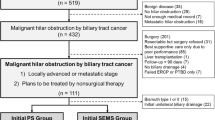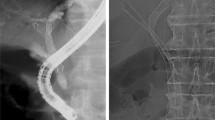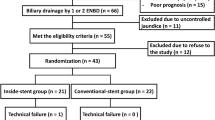Abstract
Background
The appropriate method of preoperative endoscopic biliary drainage (EBD) for cholangiocarcinoma with hilar biliary obstruction remains controversial. The inside-stent technique is a method of placing plastic stents entirely inside the bile duct. Several studies of patients with unresectable stage have reported longer stent patency compared with conventional endoscopic biliary stenting (EBS). Inside-stent techniques have been introduced as a bridge-to-surgery option and as an alternative to conventional EBS.
Aims
We aimed to evaluate the clinical outcomes of inside stent use and conventional EBS.
Methods
During this retrospective multicenter study, we reviewed consecutive patients with cholangiocarcinoma who underwent radical surgery after conventional EBS or inside-stent insertion. Adverse event (AE) rates after EBD and post-surgical AEs were compared. A multivariable analysis was performed to identify factors affecting cholangitis after EBD.
Results
Conventional EBS and inside-stent procedures were performed for 56 and 73 patients, respectively. Patient backgrounds were similar between groups, except for percutaneous transhepatic portal vein embolization. The waiting time before surgery was similar between groups (28.5 days vs. 30 days). There were no significant differences in the cholangitis rate (21.4% vs. 26.0%; P = 0.68) and all AEs (25.0% vs. 30.1%; P = 0.56) between groups. The post-surgical AE rate was similar between the groups. The multivariable analysis found that preprocedural cholangitis was a risk factor for cholangitis after EBD (odds ratio: 5.67; 95% confidence interval: 1.61–19.9).
Conclusions
The outcomes of inside-stent techniques and conventional EBS for the management of preoperative EBD are comparable for patients with cholangiocarcinoma.




Similar content being viewed by others
References
Jarnagin WR, Fong Y, DeMatteo RP et al. Staging, resectability, and outcome in 225 patients with hilar cholangiocarcinoma. Ann. Surg. 2001;234:507–519.
Rerknimitr R, Kladcharoen N, Mahachai V et al. Result of endoscopic biliary drainage in hilar cholangiocarcinoma. J. Clin. Gastroenterol. 2004;38:518–523.
Hasegawa S, Ikai I, Fujii H et al. Surgical resection of hilar cholangio-carcinoma: analysis of survival and postoperative complications. World J. Surg. 2007;31:1258–1265.
Hirano S, Tanaka E, Tsuchikawa T et al. Oncological benefit of preoperative endoscopic biliary drainage in patients with hilar cholangiocarcinoma. J. Hepatobiliary Pancreat. Sci. 2014;21:533–540.
Sakata J, Shirai Y, Tsuchiya Y et al. Preoperative cholangitis independently increases in-hospital mortality after combined major hepatic and bile duct resection for hilar cholangiocarcinoma. Langenbecks Arch. Surg. 2009;394:1065–1072.
Kawakami H, Kuwatani M, Onodera M et al. Endoscopic nasobiliary drainage is the most suitable preoperative biliary drainage method in the management of patients with hilar cholangiocarcinoma. J. Gastroenterol. 2011;46:242–248.
Kawashima H, Itoh A, Ohno E et al. Preoperative endoscopic nasobiliary drainage in 164 consecutive patients with suspected perihilar cholangiocarcinoma: a retrospective study of efficacy and risk factors related to complications. Ann. Surg. 2013;257:121–127.
Liu Q, Khay G, Cotton PB. Feasibility of stent placement above the sphincter of Oddi (“Inside-Stent”) for patients with malignant biliary obstruction. Endoscopy 1998;30:687–690.
Ishiwatari H, Hayashi T, Ono M et al. Newly designed plastic stent for endoscopic placement above the sphincter of Oddi in patients with malignant hilar biliary obstruction. Dig. Endosc. 2013;25:94–99.
Inatomi O, Bamba S, Shioya M et al. Threaded biliary inside stents are a safe and effective therapeutic option in cases of malignant hilar obstruction. BMC Gastroenterol. 2013;13:31.
Kubota K, Hasegawa S, Iwasaki A et al. Stent placement above the sphincter of Oddi permits implementation of neoadjuvant chemotherapy in patients with initially unresectable Klatskin tumor. Endosc. Int. Open 2016;4:427–433.
Kanno Y, Koshita S, Ogawa T et al. Inside plastic stents versus metal stents for treating unresectable malignant perihilar biliary obstructions: a retrospective comparative study. Clin. Endosc. 2020;53:735–742.
Kogure H, Kato H, Kawakubo K et al. A prospective multicenter study of “Inside Stents” for biliary stricture: Multicenter Evolving Inside Stent Registry (MEISteR). J. Clin. Med. 2021;30:2936.
Kobayashi N, Watanabe S, Hosono K et al. Endoscopic inside stent placement is suitable as a bridging treatment for preoperative biliary tract cancer. BMC Gastroenterol. 2015;15:8.
Takahashi Y, Sasahira N, Sasaki T et al. The role of stent placement above the papilla (inside-stent) as a bridging therapy for perihilar biliary malignancy: an initial experience. Surg. Today 2021;51:1795–1804.
Nakamura S, Ishii Y, Serikawa M et al. Utility of the inside stent as a preoperative biliary drainage method for patients with malignant perihilar biliary stricture. J. Hepatobiliary Pancreat. Sci. 2021;28:864–873.
Hameed A, Pang T, Chiou J et al. Percutaneous vs. endoscopic preoperative biliary drainage in hilar cholangiocarcinoma-a systemic review and meta-analysis. HPB (Oxford) 2016;18:400–410.
Al Mahjoub A, Menahem B, Fohlen A et al. Preoperative biliary drainage in patients with resectable perihilar cholangiocarcinoma: is percutaneous transhepatic biliary drainage safer and more effective than endoscopic biliary drainage? A meta-analysis. J. Vasc. Intervent. Radiol. 2017;28:576–582.
Celotti A, Solaini L, Montori G et al. Preoperative biliary drainage in hilar cholangiocarcinoma: systematic review and meta-analysis. Eur. J. Surg. Oncol. 2017;43:1628–1635.
Takahashi Y, Nagino M, Nishio H et al. Percutaneous transhepatic biliary drainage catheter tract recurrence in cholangiocarcinoma. Br. J. Surg. 2010;97:1860–1866.
Kishi Y, Shimada K, Nara S et al. The type of preoperative biliary drainage predicts short-term outcome after major hepatectomy. Langenbecks Arch. Surg. 2016;401:503–511.
Lin H, Li S, Liu X. The safety and efficacy of nasobiliary drainage versus biliary stenting in malignant biliary obstruction: a systematic review and meta-analysis. Medicine (Baltimore) 2016;95:e5253.
Nagino M, Hirano S, Yoshitomi H et al. Clinical practice guidelines for the management of biliary tract cancers 2019: the 3rd English edition. J. Hepatobiliary Pancreat. Sci. 2021;28:26–54.
Nakai Y, Yamamoto R, Matsuyama M et al. Multicenter study of endoscopic preoperative biliary drainage for malignant hilar biliary obstruction: E-POD hilar study. J. Gastroenterol. Hepatol. 2018;33:1146–1153.
Jo JH, Chung MJ, Han DH et al. Best options for preoperative biliary drainage in patients with Klatskin tumors. Surg. Endosc. 2017;31:422–429.
Maeda T, Ebata T, Yokoyama Y et al. Preoperative course of patients undergoing endoscopic nasobiliary drainage during the management of resectable perihilar cholangiocarcinoma. J. Hepatobiliary Pancreat. Sci. 2019;26:341–347.
Miura S, Kanno A, Masamune A et al. Bismuth classification is associated with the requirement for multiple biliary drainage in preoperative patients with malignant perihilar biliary stricture. Surg. Endosc. 2015;29:1862–1870.
Cotton PB, Eisen GM, Aabakken L et al. A lexicon for endoscopic adverse events: report of an ASGE workshop. Gastrointest. Endosc. 2010;71:446–454.
Kiriyama S, Kozaka K, Takada T et al. Tokyo guidelines 2018: diagnostic criteria and severity grading of acute cholangitis (with videos). J. Hepatobiliary Pancreat. Sci. 2018;25:17–30.
Koch M, Garden OJ, Padbury R et al. Bile leakage after hepatobiliary and pancreatic surgery: a definition and grading of severity by the International Study Group of Liver Surgery. Surgery 2010;149:680–688.
Dindo D, Demartines N, Clavien PA. Classification of surgical complications: a new proposal with evaluation in a cohort of 6336 patients and results of a survey. Ann. Surg. 2004;240:205–213.
Valle JW, Borbath I, Khan SA et al. Biliary cancer: ESMO Clinical Practice Guidelines for diagnosis, treatment and follow-up. Ann Oncol. 2016;27:v28-37.
Kurita A, Uza N, Asada M et al. Stent placement above the sphincter of Oddi is a useful option for patients with inoperable malignant hilar biliary obstruction. Surg. Endosc. 2022;36:2869–2878.
Pedersen FM, Lassen AT, de Muckadell OBS. Randomized trial of stent placed above and across the sphincter of Oddi in malignant bile duct obstruction. Gastrointest. Endosc. 1998;48:574–579.
Khashab MA, Kim K, Hutfless S et al. Predictors of early stent occlusion among plastic biliary stents. Dig. Dis. Sci. 2012;57:2446–2450. https://doi.org/10.1007/s10620-012-2178-4.
Kaneko T, Sugimori K, Shimizu Y et al. Efficacy of plastic stent placement inside bile ducts for the treatment of unresectable malignant hilar obstruction (with videos). J. Hepatobiliary Pancreat. Sci. 2014;21:349–355.
Acknowledgments
The authors gratefully acknowledge Dr. Junichi Kaneko, Dr. Junya Sato, Dr. Tatsunori Satoh, and all the members of the Division of Endoscopy at the Shizuoka Cancer Center for their assistance in this study.
Funding
This study did not receive any funding.
Author information
Authors and Affiliations
Corresponding author
Ethics declarations
Conflict of interest
H. Ishiwatari received a research grant from the Century Medical Corporation and Medico’s Hirata Inc. Y. Nakai received a research grant and a speaker’s fee from Boston Scientific, Japan. H. Isayama received research grants, scholarship contributions, and lecture fees from the Boston Scientific Corporation and Gadelius Medical K.K. T. Fujisawa received a lecture fee from the Boston Scientific Corporation.
Additional information
Publisher's Note
Springer Nature remains neutral with regard to jurisdictional claims in published maps and institutional affiliations.
Rights and permissions
Springer Nature or its licensor holds exclusive rights to this article under a publishing agreement with the author(s) or other rightsholder(s); author self-archiving of the accepted manuscript version of this article is solely governed by the terms of such publishing agreement and applicable law.
About this article
Cite this article
Ishiwatari, H., Kawabata, T., Kawashima, H. et al. Clinical Outcomes of Inside Stents and Conventional Plastic Stents as Bridge-to-Surgery Options for Malignant Hilar Biliary Obstruction. Dig Dis Sci 68, 1139–1147 (2023). https://doi.org/10.1007/s10620-022-07718-y
Received:
Accepted:
Published:
Issue Date:
DOI: https://doi.org/10.1007/s10620-022-07718-y




